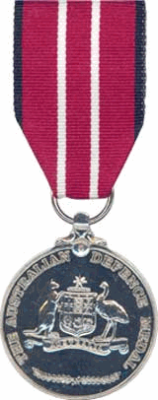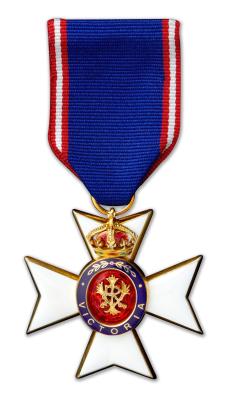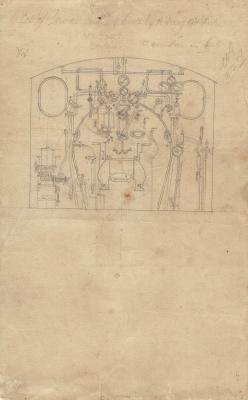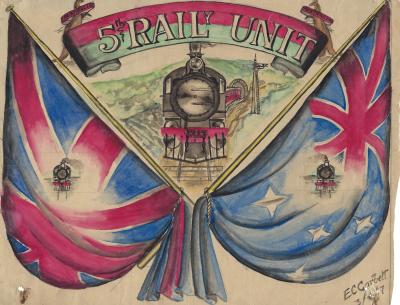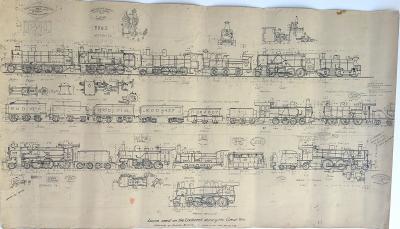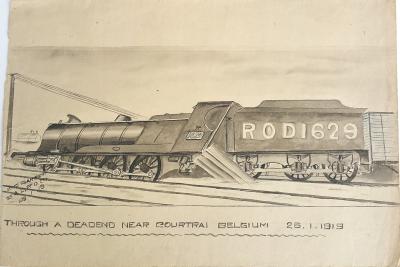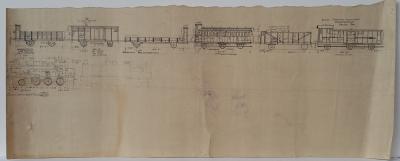Anniversary of National Service Medal
The Anniversary of National Service medal is bronze with the obverse having a central device derived from the current Australian Defence Force Emblem reflecting, more historically, national service as it related to the defence force during the 1950s and 1960s, with the crossed swords of the Army taking precedence, being the arm predominantly affected by national service. Surrounding the outer edge are the words 'ANNIVERSARY OF NATIONAL SERVICE' and at the central bottom edge, the years '1951-1972'.
The reverse side bears a central device of lines radiating from a nucleus, over-layered with the stars of the Southern Cross, representing national service being influential in the machinery of the defence force during a time of need and its broad impact in Australia. Surrounding the central device is a cog, the traditional symbol representing the spirit of cooperation between the Australian Defence Force and the Australian community, thus recognising those who accepted the obligation to serve as part of national service.
The ribbon has a central yellow stripe, flanked by two dark blue stripes, which are in turn flanked by white, green and light blue strips and ochre edges. The central yellow and dark blue stripes represent Australia's national colours of the time; the white, green and light blue represent the Navy, Army and Air Force, and the outer ochre stripes represent the Australian soil.
The Anniversary of National Service 1951-1972 Medal (ANSM) was introduced in 2001 to recognised those who completed their obligation under the two National Service schemes that had operated in Australia between 1951 and 1972.
In 1951, all men aged 18 were required to register for national service and to undertake various training obligations, depending on which force they served in. Once training was completed, national servicemen were required to remain in the Reserve for five years, with some 33,000 men being trained annually for the scheme’s first six years.
Those called up under this scheme did not see active service. In 1957, the universal obligation for national service ended and a selective system of training was introduced. This lasted until the scheme ended in 1959. Some 220,000 young Australian men served under this scheme.
The last National Service Scheme was introduced in 1964 when conflicts in Southeast Asia raised fears about Australia’s security. The National Service Bill became law in late 1964, with conscripts liable for overseas service from 1965. Selection for military service was based on a birthday ballot.
Between 1964 and 1972, more than 804,000 men registered for national service, of whom more than 63,000 were called up to serve in the Army where many were integrated into regular units that served in Vietnam. The Australian Government announced the withdrawal of troops from Vietnam in 1971, followed by the termination of the Scheme in December 1972. During the Vietnam War, more than 200 national servicemen died and more than 1200 were wounded on active service.
Details
Details
Eligibility is dependent upon a persons obligation to serve and upon this obligation being fulfilled under the National Service Act 1951 (as amended), as it applied to the individual at the time of his service. Additionally, he must not have been discharged for disciplinary reasons. No women were conscripted under the National Service Act.
Australians honour national servicemen on 14 February every year. The Australian Army Museum of WA has multiple examples of this medal in its collection to commemorate and honour this service. A photo/text exhibit outlines the four national service/conscriptions schemes from 1911-1972. Recognition of operational service may be found in the World War 2 and the Post 1945 Galleries.
Australian Army Museum of Western Australia
Australian Army Museum of Western Australia
Other items from Australian Army Museum of Western Australia
- Medal - Australian Defence Medal
- Medal - Royal Victorian Order
- Railway Operating Division - Technical Drawing, GARBETT, 1919
- Railway Operating Division - Preliminary Sketch with Measurements, GARBETT, 1918
- Railway Operating Division - Watercolour Sketch, GARBETT, 1918
- Railway Operating Division - Watercolour Postcard, GARBETT, 1917
- Railway Operating Division - Technical Drawing, GARBETT, 1918
- Railway Operating Division - Postcard, GARBETT, 1918
- Railway Operating Division - Watercolour Sketch, GARBETT, 1918
- Railway Operating Division - Watercolour Sketch, GARBETT, 1918
- Railway Operating Division - Postcard, GARBETT, 1918
- Railway Operating Division - Technical Drawing, GARBETT, 1918


Scan this QR code to open this page on your phone ->

